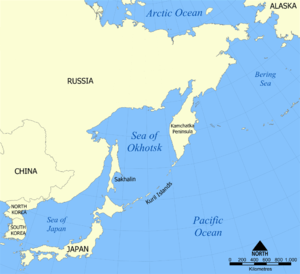Invasion of the Kuril Islands
| Invasion of the Kuril Islands | |||||||||
|---|---|---|---|---|---|---|---|---|---|
| Part of the Soviet-Japanese War | |||||||||
 Location of the Kuril Islands in the Western Pacific. | |||||||||
| |||||||||
| Belligerents | |||||||||
|
|
| ||||||||
| Commanders and leaders | |||||||||
|
|
| ||||||||
| Strength | |||||||||
| 15,000 troops | 80,000 troops [1] | ||||||||
| Casualties and losses | |||||||||
| 1,567 killed or wounded |
1,018 killed or wounded 50,422 captured | ||||||||
The Invasion of the Kuril Islands (Russian: Курильская десантная операция "Kuril Islands Landing Operation") was the World War II Soviet military operation to capture the Kuril Islands from Japan in 1945. The invasion was part of the Manchurian Strategic Offensive Operation, and was decided on when plans to land on Hokkaido were abandoned. The successful military operations of the Red Army at Mudanjiang and during the Invasion of South Sakhalin created the necessary prerequisites for invasion of the Kuril Islands.
Order of battle
- 2nd Far Eastern Front
- 101st Rifle Division
- Marine Battalion
- Howitzer Artillery Regiment
- 128th Composite Air Division (78 aircraft)
- Soviet Pacific Fleet (operating from Paul naval base)
- 60 ships and vessels
- 2nd Naval Aviation Bomber Regiment
- Coastal Artillery battery
- 5th IJA Area Army
- IJA 27th Army
- 91st Infantry Division (on about. Shumshu, Paramushir Onekotan)
- 89th Infantry Division (on about. Iturup, Kunashir, the Lesser Kuril Ridge)
- 11th Tank Regiment (Shumshu, Paramushiro)
- 31st Air Defence Regiment (Shumshu)
- 41st Independent Mixed Regiment (on about. Matua)
- 129th Independent Infantry Brigade (at about. Urup)
- IJA 27th Army
Battle
The operation took place between August 18 and September 1. The attack was made by the 87th Rifle Corps (Guards Lieutenant General A. S. Ksenofontov) of the 16th Army (Lieutenant General L. G. Cheremisov) from the 2nd Far Eastern Front, and elements of the Kamchatka Defense Area (Major General A. R. Gnechko commanding). Ships and transportation were drawn from the Petropavlovsk military base (Captain D. G. Ponomarev). The 128th Airborne Division also provied support.
The islands were occupied by the Japanese 91st Infantry Division (Shiashkotan, Paramushir, Shumshu, and Onekotan), 42nd Division (Shimushiro), 41st Independent Regiment (Matua Island), 129th Independent Brigade (Urup Island), and 89th Infantry Division (Iturup and Kunashiri). The Japanese commander was Lieutenant General Tsutsumi Fusaki.
Initial reconnaissance was undertaken on 18 August by a detachment of the 113th Separate Rifle Brigade (Captain-Lieutenant G. I. Brunshtein), carried by two mine trawlers (ТЩ-589 and ТЩ-590) to Rubetzu Bay on Iturup island. The landings on Iturup were continued by the 355th Rifle Division, which also landed on the smaller island of Urup.
On August 23, the 20,000-strong Japanese garrisons on the islands were ordered to surrender as part of the general surrender of Japan. However, some of the garrison forces ignored this order and continued to resist Soviet occupation.[2]
From 22 to 28 August, troops of the Kamchatka Defense Area occupied the Kuril Islands from Urup north.
On 1 September, elements of the 87th Rifle Corps were landed by torpedo boats, mine trawlers and transports (departing from Otomari) on Kunashir and Shikotan in the southern Kuril Islands. This was an assault landing against Japanese resistance. On 4 September, 87th Rifle Corps occupied five smaller islands (Sibotzu, Taraku-Shima, Uri-Shima, Akiuri, and Suiseto).[2]
After September 4, Soviet forces occupied the rest of the Kuril Islands without further resistance.
The islands remained part of Russia after the dissolution of the Soviet Union.
See also
References
- ↑ Glantz, David. August Storm: The Soviet 1945 Strategic Offensive in Manchuria. Portland, Oregon: Frank Cass Publishers. p. 8.
- 1 2 Glantz, David. August Storm: The Soviet 1945 Strategic Offensive in Manchuria. Portland, Oregon: FRANK CASS PUBLISHERS. pp. 299–300.
